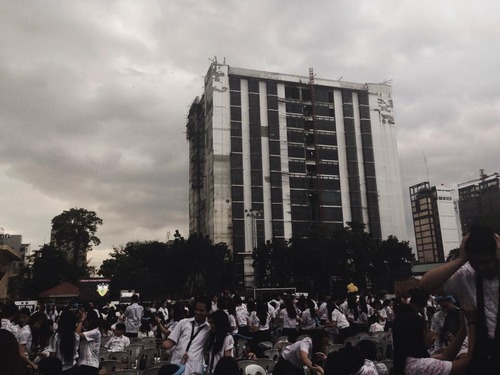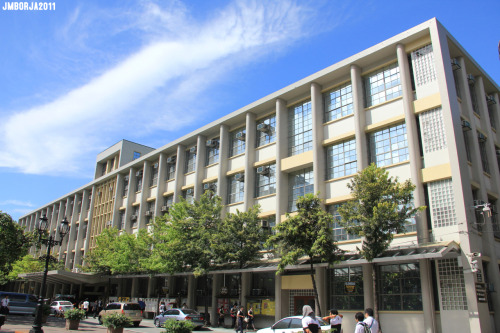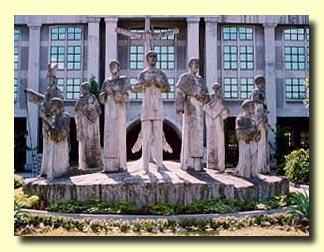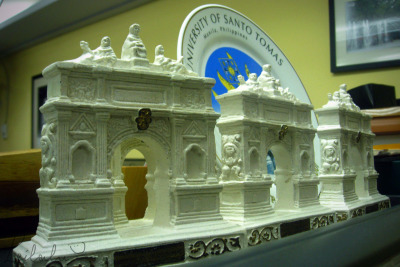Post by Tom A. Saiyan on Aug 16, 2014 3:27:33 GMT
Alumni building to house classrooms
increased its freshmen admission this year despite overcrowding in several colleges, but is already making adjustments to accommodate the Thomasian population by utilizing new classrooms and fixing class schedules.
As a solution to overcrowding, the new Thomasian Alumni Center will be opened by the first week of regular classes for several colleges.
UST Rector Rev. Fr. Herminio Dagohoy, O.P. said 43 new classrooms at the Alumni Center that are expected to be used by the College of Tourism and Hospitality Management, the Faculty of Engineering, and the Faculty of Arts and Letters (Artlets).
Office for Admissions Director Marie Vargas said proper management of the use of facilities and time were needed to prevent overcrowding in some colleges.
“A room that is vacant for a certain schedule is already a waste of money because that could have been used by another section in another program,” she said.
The number of freshmen enrollees this academic year increased by 7.8 percent or 946 Thomasians compared with last year, however, the total student population decreased by 5 percent or 2,167 students.
This academic year, the top three colleges with the highest number of freshmen students are the Faculty of Engineering with 2,190, which increased by 41 percent from last year’s 1,549; the Artlets with 1,371, which went up by 22 percent from last year’s 1,120; and the Graduate School with 1,257, which decreased by 36.5 percent from last year’s 1,978.
Meanwhile, the Faculty of Engineering remains the most populated college in the University with 6,672 students, followed by the Artlets with 4,204 students, and the AMV-College of Accountancy with 3,869 students, data from the University registrar showed.
Vargas assured that the University could accommodate a big number of applicants without sacrificing quality education.
“It is a matter of managing the use of the different classrooms in different buildings,” said Vargas.
St. Raymund de Peñafort is the most crowded building in the University, housing two of the largest student populations—those of Artlets and the College of Commerce and Business Administration.
To minimize the impact of the increase in freshmen, Artlets Dean Michael Anthony Vasco said they will have to maximize the use of their classrooms by having more class shifts to accommodate all students.
“Before, 75 percent of our class sections already had three shifts, which are four hours each. This academic year, all of the class sections will have three shifts in their schedules,” Vasco said.
Last year, Artlets held some of its classes in the College of Commerce and the Thomas Aquinas Research Complex because of lack of classrooms.
There is enough to be able to meet the Artlets’ needs despite the increase of freshmen, Vasco said and Artlets has even started the installation of LED television units to replace LCD projectors in several classrooms.
From last year’s 23 sections, the number of sections increased to 32 which Vasco attributed to the distribution of 45 students per section.
Meanwhile, the UST Main Building is considered the third most populated building in the University, housing the Faculty of Pharmacy, the College of Science, and the Graduate School.
Science Dean John Ramos said they had enough facilities and rooms to accommodate the sixth largest student population in the University, occupying 32 classrooms and 14 laboratories.
The highest class size belongs to the freshmen, with 45 to 47 students per class, while the lowest class size belongs to the seniors with around 38 students per class.
“While it is true that we increased our freshmen sections by four, there’s no need for us to have Saturday classes,” Ramos said. “Although, we might extend our classes up to 8 p.m. for the higher years [for this] academic year, it will still be limited to Mondays to Fridays. And we only have two shifts—morning and afternoon.”
K to 12 pushes freshmen increase
Vargas said the University increased its freshmen admission for this academic year to prepare for the upcoming adjustment period of the K to 12 program in 2016.
Instead of proceeding to higher education institutions (HEIs), fourth year or Grade 10 students will enter Grades 11 and 12 in Senior High School as required by the K to 12. During this period, UST and many other HEIs will suffer from a significant decrease in freshmen enrollees.
However, Dagohoy denied that the sudden increase of freshmen was a part of the University’s plan to prepare for the transition period.
“I think some colleges have seriously expanded the program because of so many applicants.” Dagohoy said.
He said there were no estimates yet regarding the number of students entering the University in 2016.
“We will know the actual scenario when we have the entrance examinations in 2016,” Dagohoy said.
However, Dagohoy assured that the University would be setting up its own senior high school program for the K to 12 program.
Marishirl Tropicales, UST High School principal, said its faculty members would not be affected in terms of teaching load but just adjustments were being made in the curriculum and in terms of assessment.
Faculty won’t be put at stake
Lingayen-Dagupan Archbishop Socrates Villegas, also the Catholic Bishops’ Conference of the Philippines president, said in a statement that having no freshmen attending in the first year of the implementation of K to 12 is the most pressing problem for Catholic HEIs.
“We urge the trustees of our Catholic school corporations and school officials to be creative, to provide opportunities for the re-tooling and re-training of our instructors and professors in tertiary education to be able to handle subjects in senior high school,” Villegas said.
Based on the estimation by the Council of Teachers and Staff of Colleges and Universities, more than 85,000 HEI faculty and non-teaching staff would be affected by the implementation of K to 12 in 2016.
Villegas added that Catholic colleges should open their own senior high school programs, noting that this should not be problematic because most of colleges already offer secondary education.
Designed to help the students develop skills that are fit for tertiary education, the K to 12 program was signed into law by President Aquino last May 15, 2013.
K to 12 “covers Kindergarten and 12 years of basic education to provide sufficient time for mastery of concept and skills, develop lifelong learners, and prepare graduates for tertiary education, middle-level skills development, employment and entrepreneurship,” according to the Official Gazette. M. G. C. Esmaya and M. G. S. Ropero
increased its freshmen admission this year despite overcrowding in several colleges, but is already making adjustments to accommodate the Thomasian population by utilizing new classrooms and fixing class schedules.
As a solution to overcrowding, the new Thomasian Alumni Center will be opened by the first week of regular classes for several colleges.
UST Rector Rev. Fr. Herminio Dagohoy, O.P. said 43 new classrooms at the Alumni Center that are expected to be used by the College of Tourism and Hospitality Management, the Faculty of Engineering, and the Faculty of Arts and Letters (Artlets).
Office for Admissions Director Marie Vargas said proper management of the use of facilities and time were needed to prevent overcrowding in some colleges.
“A room that is vacant for a certain schedule is already a waste of money because that could have been used by another section in another program,” she said.
The number of freshmen enrollees this academic year increased by 7.8 percent or 946 Thomasians compared with last year, however, the total student population decreased by 5 percent or 2,167 students.
This academic year, the top three colleges with the highest number of freshmen students are the Faculty of Engineering with 2,190, which increased by 41 percent from last year’s 1,549; the Artlets with 1,371, which went up by 22 percent from last year’s 1,120; and the Graduate School with 1,257, which decreased by 36.5 percent from last year’s 1,978.
Meanwhile, the Faculty of Engineering remains the most populated college in the University with 6,672 students, followed by the Artlets with 4,204 students, and the AMV-College of Accountancy with 3,869 students, data from the University registrar showed.
Vargas assured that the University could accommodate a big number of applicants without sacrificing quality education.
“It is a matter of managing the use of the different classrooms in different buildings,” said Vargas.
St. Raymund de Peñafort is the most crowded building in the University, housing two of the largest student populations—those of Artlets and the College of Commerce and Business Administration.
To minimize the impact of the increase in freshmen, Artlets Dean Michael Anthony Vasco said they will have to maximize the use of their classrooms by having more class shifts to accommodate all students.
“Before, 75 percent of our class sections already had three shifts, which are four hours each. This academic year, all of the class sections will have three shifts in their schedules,” Vasco said.
Last year, Artlets held some of its classes in the College of Commerce and the Thomas Aquinas Research Complex because of lack of classrooms.
There is enough to be able to meet the Artlets’ needs despite the increase of freshmen, Vasco said and Artlets has even started the installation of LED television units to replace LCD projectors in several classrooms.
From last year’s 23 sections, the number of sections increased to 32 which Vasco attributed to the distribution of 45 students per section.
Meanwhile, the UST Main Building is considered the third most populated building in the University, housing the Faculty of Pharmacy, the College of Science, and the Graduate School.
Science Dean John Ramos said they had enough facilities and rooms to accommodate the sixth largest student population in the University, occupying 32 classrooms and 14 laboratories.
The highest class size belongs to the freshmen, with 45 to 47 students per class, while the lowest class size belongs to the seniors with around 38 students per class.
“While it is true that we increased our freshmen sections by four, there’s no need for us to have Saturday classes,” Ramos said. “Although, we might extend our classes up to 8 p.m. for the higher years [for this] academic year, it will still be limited to Mondays to Fridays. And we only have two shifts—morning and afternoon.”
K to 12 pushes freshmen increase
Vargas said the University increased its freshmen admission for this academic year to prepare for the upcoming adjustment period of the K to 12 program in 2016.
Instead of proceeding to higher education institutions (HEIs), fourth year or Grade 10 students will enter Grades 11 and 12 in Senior High School as required by the K to 12. During this period, UST and many other HEIs will suffer from a significant decrease in freshmen enrollees.
However, Dagohoy denied that the sudden increase of freshmen was a part of the University’s plan to prepare for the transition period.
“I think some colleges have seriously expanded the program because of so many applicants.” Dagohoy said.
He said there were no estimates yet regarding the number of students entering the University in 2016.
“We will know the actual scenario when we have the entrance examinations in 2016,” Dagohoy said.
However, Dagohoy assured that the University would be setting up its own senior high school program for the K to 12 program.
Marishirl Tropicales, UST High School principal, said its faculty members would not be affected in terms of teaching load but just adjustments were being made in the curriculum and in terms of assessment.
Faculty won’t be put at stake
Lingayen-Dagupan Archbishop Socrates Villegas, also the Catholic Bishops’ Conference of the Philippines president, said in a statement that having no freshmen attending in the first year of the implementation of K to 12 is the most pressing problem for Catholic HEIs.
“We urge the trustees of our Catholic school corporations and school officials to be creative, to provide opportunities for the re-tooling and re-training of our instructors and professors in tertiary education to be able to handle subjects in senior high school,” Villegas said.
Based on the estimation by the Council of Teachers and Staff of Colleges and Universities, more than 85,000 HEI faculty and non-teaching staff would be affected by the implementation of K to 12 in 2016.
Villegas added that Catholic colleges should open their own senior high school programs, noting that this should not be problematic because most of colleges already offer secondary education.
Designed to help the students develop skills that are fit for tertiary education, the K to 12 program was signed into law by President Aquino last May 15, 2013.
K to 12 “covers Kindergarten and 12 years of basic education to provide sufficient time for mastery of concept and skills, develop lifelong learners, and prepare graduates for tertiary education, middle-level skills development, employment and entrepreneurship,” according to the Official Gazette. M. G. C. Esmaya and M. G. S. Ropero



























